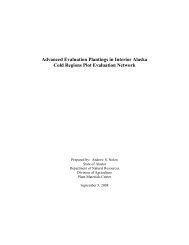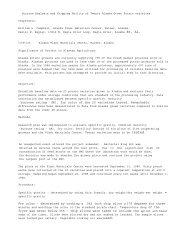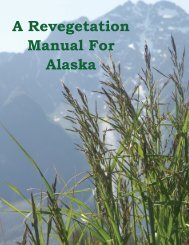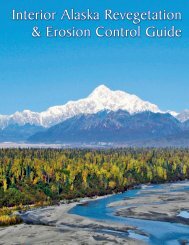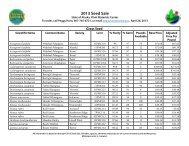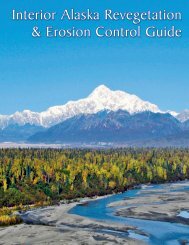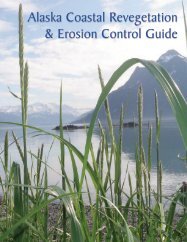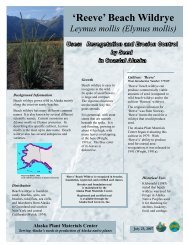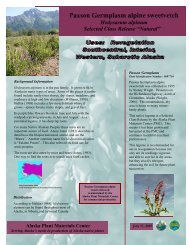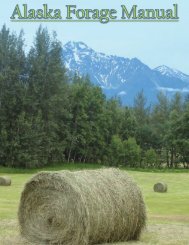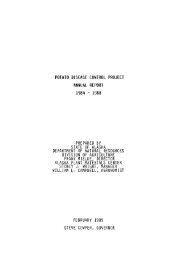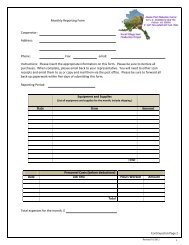Alaska Forage Manual - Alaska Plant Materials Center - State of ...
Alaska Forage Manual - Alaska Plant Materials Center - State of ...
Alaska Forage Manual - Alaska Plant Materials Center - State of ...
Create successful ePaper yourself
Turn your PDF publications into a flip-book with our unique Google optimized e-Paper software.
Grazing Pasture<br />
Hay Cropping<br />
Cattle graze on pasture land in Southcentral <strong>Alaska</strong>.<br />
Pasture is land with vegetation cover<br />
consisting <strong>of</strong> grasses and legumes used for<br />
livestock in a farm setting. Pastureland can also<br />
be used by wild animals for grazing or browsing<br />
purposes. In most cases, cultivated forage<br />
crops produce higher yields than most native<br />
forages. Crops are consumed during different<br />
stages <strong>of</strong> growth.<br />
Control and regulation <strong>of</strong> grazing intensity,<br />
timing, frequency and selectivity are dictated<br />
by the producer to control the effects<br />
<strong>of</strong> grazing animals on plants (Holechek, Pieper<br />
& Herbel, 2004, p. 127). A study from Owen et<br />
al. 1998 found that a high intensity overgrazed<br />
pasture ultimately causes plant death. It was<br />
found that grasses can be grazed without damage<br />
if 50% to 70% <strong>of</strong> the leaf and stem material<br />
by weight is left intact as a metabolic reserve.<br />
The remaining 30% to 50% is considered “surplus”<br />
that can be consumed.<br />
Photo: Cindy Gallagher, AK PMC<br />
Photo: <strong>Alaska</strong> Division <strong>of</strong> Agriculture<br />
Bales <strong>of</strong> hay typically contain 10 to 20% moisture.<br />
Hay is a major source <strong>of</strong> fodder for the<br />
livestock industry during the dormant season.<br />
Grasses, legumes, or other herbaceous plants<br />
are <strong>of</strong>ten used as a hay source. At roughly 25%<br />
moisture content - plants are cut, left to cure or<br />
wilt in the field and then processed into bales.<br />
Hay is then used as animal feed when grazing<br />
pasture is unavailable due to cold temperatures<br />
or when animals are kept in a barn or other enclosed<br />
area.<br />
Hay is sensitive to weather conditions<br />
which can play a large role in the quality <strong>of</strong> the<br />
product. If harvested in a drought year, plant<br />
quality and hay production may be diminished.<br />
In wet weather, the cut hay may spoil prior to<br />
baling or develop rot and mold once baled. Potential<br />
toxins then become a concern, as animals<br />
can become sick if they are fed spoiled<br />
hay. Musty and/or mildewy odors indicate the<br />
presence <strong>of</strong> mold within hay.<br />
Photo: Casey Dinkel, AK PMC<br />
At left:<br />
Hay bales can be subject to free grazing by<br />
moose if not protected or stored properly.<br />
7



